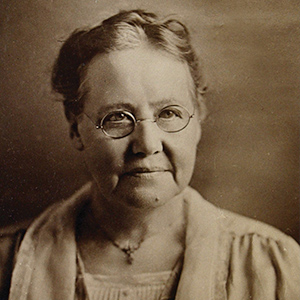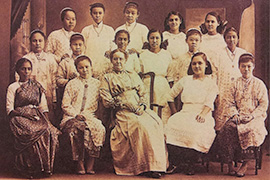
BORN
1857
INDUCTED
2014
CATEGORY
Education

THE HONOURED INDUCTEES TO THE SINGAPORE WOMEN’S HALL OF FAME
Sophia Blackmore
Founder of Methodist Girls’ School
Sophia Blackmore was born on 18 October 1857 to a devout Christian family in Goulburn, New South Wales. In her late 20s, influenced by a visiting American missionary, Sophia went to India with the intention of serving as a missionary in China. But a chance meeting with Reverend William Oldham, founder of the Methodist Mission and ACS in Singapore, made her decide to go instead to Malaya.
In 1887 she became the first woman missionary sent by the Methodist Women’s Foreign Missionary Society to Singapore. This was the start of Sophia’s four decades of community and social service work in Singapore, and which resulted in a legacy as one of the early pioneers of education for girls in Singapore, as well as founding two well-known schools and a church.
Within a month of her arrival in Singapore, Sophia, with the help of the Indian community, established a school for Tamil girls. The girls were daughters of Tamil businessmen who readily provided the money, furniture and rent-free shophouse for a school at Short Street. This would later become Methodist Girls’ School, which was relocated to Mount Sophia in 1925, and then to Blackmore Drive in 1992.
Sophia also set up another school which had a more challenging beginning. In this case she had to battle the mindset among Chinese families that girls did not need education and went door to door to recruit girls from the Peranakan community.
With a pioneer batch of eight Nonya girls, the Anglo-Chinese Girls’ School began in 1888 and eventually became the present Fairfield Methodist Secondary School. Another of Sophia’s initiatives was a boarding home, known as Nind Home, for school-going girls, runaways, abandoned children and orphans.
Sophia, who while in India had begun to study Malay, picked up Baba Malay, the conversational Malay that was the lingua franca on the streets of multiracial Singapore. She became proficient enough to translate hymns and preach in Malay on Sundays to the girls from the Nind Home and to workers from the Missionary Press. She also preached in the open at Telok Ayer, laying the foundations for what was to become the Kampong Kapor Methodist Church.
She also published a Christian periodical, Sahabat, in Baba Malay. Meant for women, it became so popular it was widely distributed in Malaya.
In 1927, Sophia retired and went back to Australia, but returned to Singapore for several visits before World War II.
Sophia Blackmore passed away, aged 88, in 1945 in Australia.

Sophia Blackmore
Founder of Methodist Girls’ School
BORN 1857 INDUCTED 2014
CATEGORY Education
Sophia Blackmore was born on 18 October 1857 to a devout Christian family in Goulburn, New South Wales. In her late 20s, influenced by a visiting American missionary, Sophia went to India with the intention of serving as a missionary in China. But a chance meeting with Reverend William Oldham, founder of the Methodist Mission and ACS in Singapore, made her decide to go instead to Malaya.
In 1887 she became the first woman missionary sent by the Methodist Women’s Foreign Missionary Society to Singapore. This was the start of Sophia’s four decades of community and social service work in Singapore, and which resulted in a legacy as one of the early pioneers of education for girls in Singapore, as well as founding two well-known schools and a church.
Within a month of her arrival in Singapore, Sophia, with the help of the Indian community, established a school for Tamil girls. The girls were daughters of Tamil businessmen who readily provided the money, furniture and rent-free shophouse for a school at Short Street. This would later become Methodist Girls’ School, which was relocated to Mount Sophia in 1925, and then to Blackmore Drive in 1992.
Sophia also set up another school which had a more challenging beginning. In this case she had to battle the mindset among Chinese families that girls did not need education and went door to door to recruit girls from the Peranakan community.
With a pioneer batch of eight Nonya girls, the Anglo-Chinese Girls’ School began in 1888 and eventually became the present Fairfield Methodist Secondary School. Another of Sophia’s initiatives was a boarding home, known as Nind Home, for school-going girls, runaways, abandoned children and orphans.
Sophia, who while in India had begun to study Malay, picked up Baba Malay, the conversational Malay that was the lingua franca on the streets of multiracial Singapore. She became proficient enough to translate hymns and preach in Malay on Sundays to the girls from the Nind Home and to workers from the Missionary Press. She also preached in the open at Telok Ayer, laying the foundations for what was to become the Kampong Kapor Methodist Church.
She also published a Christian periodical, Sahabat, in Baba Malay. Meant for women, it became so popular it was widely distributed in Malaya.
In 1927, Sophia retired and went back to Australia, but returned to Singapore for several visits before World War II.
Sophia Blackmore passed away, aged 88, in 1945 in Australia.
“When Miss Blackmore departs for her home in Australia, she will carry with her the deep affection of several generations of Chinese girls, and she will leave behind in our local annals a fine record of difficult and useful work done, and a memory of personal influence, character, and example which has been of very great value in this era of changing traditions and ideas among our Asiatic communities in the Straits.”
Gallery photo(s):
Photo Courtesy of Lee Hin Ming Collection, courtesy of National Archives of Singapore.
Profile last updated: 11th March 2021

